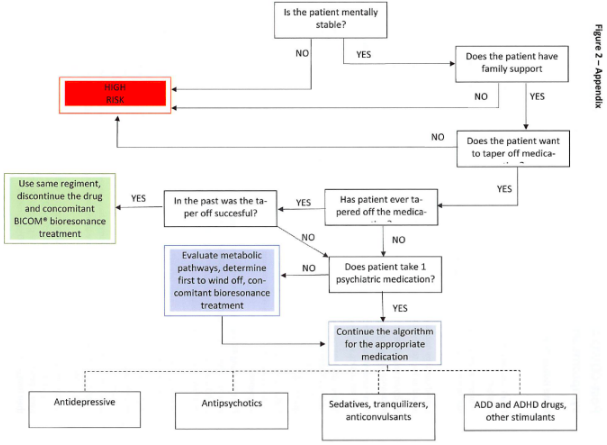
Harmfull effects and blockages of psychiatric medications in our BICOM® Practices
Dr. med. Antonina Rome, MD, Ljubljana, Slovenia
Introduction
With the development of psychoenergetic methods of treatment with BICOM® bioresonance, we have encountered one of the major conflicts in practice. On the one hand we have subtle energetic testing and identification of blockages and their treatment. On the other hand we have a patient who still takes psychiatric drugs, even cocktails of them, on a biochemical level, which is a barrier to progress due to the resulting blockages at the target levels affected by the drug. In our work we have found that such patients have a more difficult response to BICOM® bioresonance therapy, and we have sought further solutions, exploring other literature and integrating it into our bioresonance work. In this paper we will look at the background to psychiatric drugs, the problems they cause in the body and in our therapies. | will present an algorithm and an example of how we deal with this kind of difficult patients. As the field is very broad, we will focus mainly on antidepressants.
Background to psychiatric medicines
The term “chemical imbalance in the brain” came into use in the 1960s. In the 1990s, the theory was vigorously promoted by the pharmaceutical industry to market a new type of antidepressants known as Selective Serotonin Reuptake Inhibitors (SSRIs), an idea that was also supported by official institutions such as the American Psychiatric Association, which continues to convince the public that “differences in certain brain chemicals may contribute to symptoms of depression”.
People accepted what the doctors were telling them. Many started taking antidepressants because they believed there was something wrong with their brains. During this period of marketing pressure, the use of antidepressants has increased dramatically, as they can be prescribed by any doctor (not just a specialist) without any laboratory tests. And, in fact, psychiatric illnesses are the only ones for which there is no laboratory evidence.
Due to the lack of evidence that the patient really has a neurotransmitter disorder that intensive and large-scale studies have been launched, but they lacked a systematic review.
On 20 July 2022, Molecular Psychiatry published an umbrella review!. The review involved a systematic identification and synthesis of existing evidence from all the major areas of serotonin and depression research. Although there have been systematic reviews of individual areas in the past, none has synthesised evidence from all the different areas with such a comprehensive approach.
No evidence
1): One of the areas of research they included was research comparing levels of serotonin and its breakdown products in blood or cerebrospinal fluid. These studies showed no differences between depressed and non-depressed subjects.
2): Another area of research has focused on serotonin receptors, which are proteins at the end of nerves that serotonin binds to, and which can transmit or inhibit the effects of serotonin. Research on the most commonly studied serotonin receptors has shown that there are no differences between depressed and non-depressed people, or that serotonin activity is actually increased in depressed people, which is the opposite of the predictions of the serotonin theory.
3): Research on the serotonin ‘transporter’ (SERT), a protein that helps to terminate the effect of serotonin and on which SSRI drugs act, has also shown that serotonin activity is increased, if at all, in people with depression. However, these findings may be explained by the fact that many of the participants in these studies have used or are currently using antidepressants.
4): They also reviewed studies that looked at whether artificially lowering serotonin levels can cause depression in volunteers?. Two systematic reviews of studies from 20063 and 20074 and a sample of 10 recent studies (at the time of the umbrella study) showed that lowering serotonin did not cause depression in hundreds of healthy volunteers.
5): Very large studies® involving tens of thousands of patients have looked at variations in genes, including the SERT gene, which has instructions for making the serotonin transporter. No differences in the frequency of variants in this gene were found between depressed subjects and healthy controls.
Although a well-known study® has found a link between the serotonin transporter gene and stressful life events, much larger and more comprehensive studies ” show that no such link exists. However, stressful life events themselves have been shown to have a strong impact on the subsequent risk of developing depression.
6): Some of the studies in the review?, which included people taking or who had previously taken antidepressants, showed that antidepressants can actually reduce the concentration or activity of serotonin.
So what now, when the studies have turned everything upside down?
Are there solutions? The serotonin theory of depression has been one of the most influential and “researched” biological theories of the origins of depression. The review study mentioned above showed that this view is not supported by scientific evidence. It also calls into question the basis for the use of antidepressants. There is no other accepted pharmacological mechanism by which antidepressants may affect depression. If antidepressants work as a placebo or by numbing emotions, then the answer is now clearer to the question: are they really more beneficial than harmful?
With a lighter heart, we have started to develop protocols and solutions for weaning off psychiatric drugs in general in our practices.
Overactivation of INK gene
In 2004, a private US company started researching the effect of psychiatric drugs on the JNK gene®. They found that psychiatric drugs cause overexpression of the JNK gene. The discovery was made while investigating why 50% of patients experience more severe withdrawal reactions when stopping psychiatric drugs, whether diazepines, antidepressants or antipsychotics. So the statement that antidepressants or antipsychotics do not cause withdrawal symptoms or dependence has become false. And they are still wrong.
What are JNK genes?
JNK genes are involved in the regulation of many cellular activities, from proliferation to cell death. While JNK1 and JNK2 are widely expressed in all body tissues, INK3 is expressed only in the central nervous system (CNS) (with a very high level), cardiac smooth muscle and testis (low level).
JNK3 is primarily localized in CNS neurons and is also the most responsive isoform to stressstimuli. In addition, it has been implicated in several neurodegenerative diseases, including Alzheimer’s disease, Parkinson’s disease and stroke. All this contributes to make JNK3 an attractive CNS drug target.
JNK genes are closely involved in the plasticity of the dendritic synapses and in their stability. Nowadays, it is well known that the JNK kinase is involved in a wide variety of brain diseases, in particular through its isoform JNK31. (see Fig. 1).
A variety of stress stimuli includig psychiatric medications activate JNK genes and neurodegenerative inflammatory processes start.
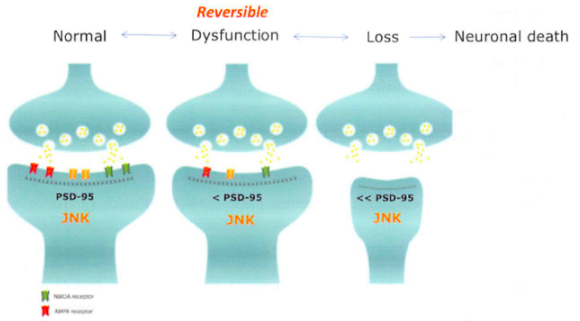
Fig.1 Synaptic pathology.
INK3 is a key player in synaptic dysfunction. Synaptic dysfunction is a dynamic process composed of an initial reversible phase, during which synaptic function is impaired, followed by spine injury that can progress to an irreversible stage, and is associated with synaptic loss. This second phase progresses to neuronal death and, consequently, loss of functionality of the affected brain areas and cognitive impairment’®
A study in 2018 confirmed that overactive JNKs are associated with inflammation, neurodegeneration and insulin resistance. 1
A 2020 study found that LipoPolySacharides infusion led to depressive-like behaviors, accompanied by increased proinflammatory cytokine expression and increased JNK activation.!?
In the meantime, there have been 16 years of constant reactivation of this gene with psychiatric drugs and deteriorating conditions in patients, too many withdrawal symptoms that made it impossible for the patient to safely taper off the drug, and several pages of side-effect lists.
By knowing all these backgrounds given here we can then better understand our algorithms and bioresonance protocols in the next sections.
Bioresonance algorithm and protocol
Everyone in their BICOM® practice encounters patients taking one or more psychiatric drugs. We can confirm that such patients are either a harder nut to crack in treatment or have more frequent
relapses of the underlying illness.
Firstly, it is important to realise that psychiatric drugs are primarily nervous system blockages, so we start discussing with the patient the possibility of discontinuing them at the very beginning, at the stage of treating blockages in the body with BICOM® bioresonance. This is because psychiatric drugs cause blockages and havoc on further levels as well.
Patients express many different statements:
“I was even more numb.”
“I failed to finish number 8 in my writing at school.”
“I had more headaches when | quit.”
“Electric currents went through my brain and spine.” (These are known withdrawal symptoms called electric zaps)
“I’m overweight, and | don’t even eat that much”
“I had a feeling of constant drunkenness”
“I couldn’t concentrate”
Then a patient who states that it helped him, it helped numb his emotions, cut off the intensity of the emotions so that he didn’t suffer so much. Years and years of taking psychoactive medicine concentrate the patient’s life energy into masses that are no longer responsive. Over 20 years of working with patients, an algorithm has been developed, which is presented in Figure 2 in the appendix.
It also happens that we have to turn down a certain percentage of patients or end their treatment early, as they can pose a significant risk to the energetic well-being of our practice. We also want to cooperate with an aware psychiatrist or personal physician to wean off medication if possible.
We therefore assess the patient’s psycho-physical state over the last 12 months, which is best done by asking whether they have required many psychiatric visits or hospital treatments or have been re-hospitalised in the last 12 months. These are higher risk patients for us.
The support of the surrounding community, especially family members, is another essential criterion. A person whose family situation has led them onto the psychiatric path and where the situation persists is also a high risk to our treatment success.
If we don’t have the patient’s willingness and cooperation, we continue with the BICOM® therapies in our practice, but the success rate is less. We want to achieve some improvement in these patients, so that they gain confidence in bioresonance and over time develop the awareness that help and success are possible even for their psychiatric condition and that they do not need medication.
If the patient has successfully come off the medication in the past, the same procedure is followed with simultaneous BICOM® bioresonance support.
Otherwise, it is important to remember that the more medication the patient is on, the more urgent it is to find an order of discontinuation with concomitant bioresonance therapies.
The algorithm and protocol follow the following facts or rules:
The first fact is that psychiatric drugs cause metabolic disorders.
Second fact: All psychoactive medications alter the Hypothalamic Pituitary-Adrenal Axis (HPA) to some degree.
Third fact: All psychoactive medications metabolize through specific pathways called cytochrom P450% and its subtyps. 1%
Fourth fact: Adverse side reactions start when the drug saturates these enzymes.
Fifth fact: The first drug to be tapered off is the one metabolised via the least CYP450 subenzyme groups.
The following chart details the P450 enzymes used to metabolize the most common antidepressants. An X in the row denotes that the medication utilizes that specific pathway.
A (+ number) denotes how many other metabolic pathways the medication will also use.
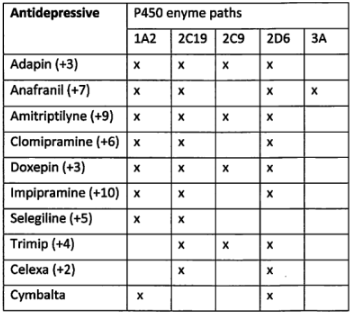
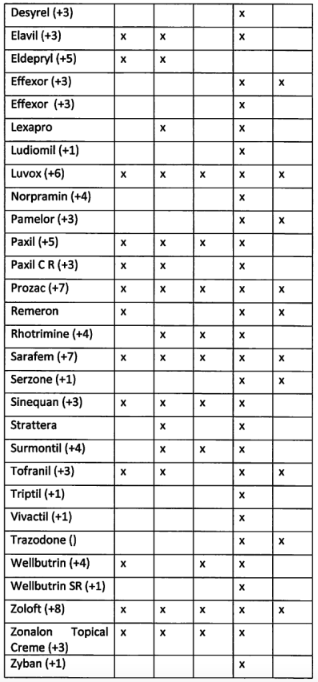
If you have two or more medications sharing the same CYP pathway to metabolize, reduce the medication that uses the fewest pathways first. Or start with the one which caused more side effects or worsened those.
From these five rules, we can now more easily derive our bioresonance protocols. Of course, there is no one set pattern of treatment and procedure, but rather the above 5 facts must be taken into
account when looking for indication programmes, considering also the patient’s medical history, the algorithm, the standard bioresonance protocol and our bioresonance diagnostic outcome.
Therefore, when selecting BICOM® programmes, we have in mind mainly the following areas and their corresponding programme categories that are targeted by the medicines (the categories are grouped in a meaningful way according to the target areas). Also added are suggestions for CTT sets containing highly relevant ampoules (the rows in this column do not coincide with the target areas, they are just listed as a suggestion for the selection).
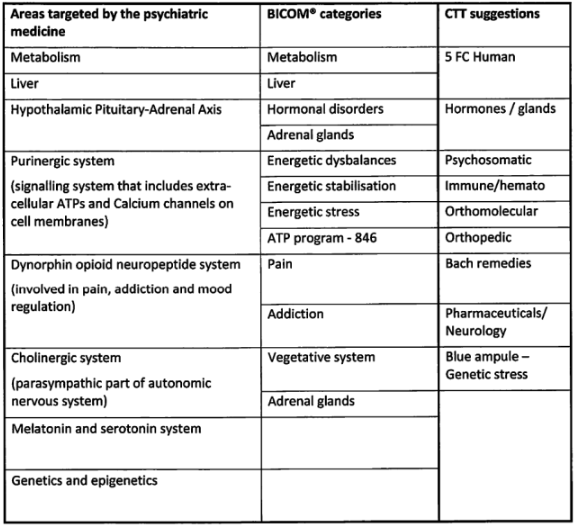
At the first appointment, a treatment plan is drawn up and the patient is also presented with dietary recommendations if they have tested positive. The patient is prescribed a triglyceride form of omega-3 – high in content of EPA and DHA, i.e. above 250mg of pure EPA and DHA. We reccomend also Vitamin E in the form of mixed tocopherols and tocotrienols. For female patients, we prescribe 6001U of vitamin E and for males, 12001U. Dietary measures and supplements are started immediately after the first visit. At this time the patient also continues his/her medication. The metabolic disorder occurs while taking the drug as well as when you begin reducing the drug.
Only after 2 weeks or even 3 weeks, when the patient notices that their general condition is improving, do we allow the dose of the antidepressant to be reduced by half. In the meantime, we carry out regular bioresonance treatments. If they have withdrawal symptoms at the time of the reduction, omega 3 is increased a few days before and bioresonance support is given. After three days, omega 3 can be resumed at the original starting dose.
The dose is halved every 14 days.
QOur aim is to help the patient to taper off the medicine without withdrawal reactions and to continue with the bioresonance treatment plan for which they originally came. Treatment and discontinuation of the medication is an intermediate step and most often a blocking element.
Case study
A 50-year-old female patient came to our centre because she wanted to come off an antidepressant under professional supervision as well as suffering from constant tiredness. She has been treated for depression for 13 years. She had tried to come off the medication several times, considering she had sorted her life out. When stopping the antidepressant Cipramil (citalopram – in our table above equivalent to Celexa) after three years of taking it, she had withdrawal reactions such as weakness, fever, fogginess in the head. She found it difficult to tolerate the hormonal IUD, and her feelings of depression were exacerbated. So they changed her medication to Cymbalta. It was only when the hormonal IUD was removed that she felt better.
At that point she wanted to stop taking the antidepressant again, but her psychiatrist advised her to continue. She has high cholesterol and thyroid problems. Emotionally, she describes herself as anxious, trapped, powerless, crying a lot. She still menstruates, also has significant PMS. Psychoactive medications play havoc with the HPA. When the HPA is out of balance, you will have a problem with insulin, stress, anxiety, weight gain, thyroid problems, fatigue, unbalanced sexual hormones and countless other body difficulties.
Antidepressants cause these physical conditions and consequently physical symptoms that can be mistaken for other conditions or even depression itself, making withdrawal from any psychoactive substance even more confusing for both the individual and their doctor. Unless, of course, he or she is aware of the facts described in this congress paper.
So we introduced a dietary supplement regimen for the patient. We were in regular communication via email for encouragement and motivation. According to our patient’s medical history she was in the group of 50% of people who have withdrawal reactions when they quit psychoactive medicines. Personally, | consider everyone in this category at first.
In the meridian system, | found the yang state on the meridian of the nervous system and the hormonal system. Of the stresses, the most critical were disturbed elimination and heavy metals.
Last were never treated as they no longer tested positive after the drug was discontinued and the elimination organs – the liver with the drug16 – were treated. The therapeutic programmes that mainly tested positive were in the liver group and the hormonal system (the HPA axis).
She has successfully come off the drug and wrote the following thoughts:
“It has been an interesting journey over the last few months. What the psychiatrist described as my underlying illness, which occurred when | was tapering off the antidepressant, was in fact a mixture of withdrawal symptoms, which | was experiencing exactly as described in the literature of Dr. Rome. | experienced them as unusual headaches (feeling “light-headed”) and nausea (like driving with a bus). My confidence in Dr Rome and her expert programme gave me the courage to start and successfully complete the supervised withdrawal program.
So today, | am antidepressant-free, with no feeling of fogginess, no nausea and no signs of depression. | am happy that it has been confirmed that I really do not need an antidepressant. | am happy because | feel that | am in control of my own life. That my feelings and emotions, whatever they may be, are genuine, truly mine and independent of chemicals. That | am no longer living in a fog of intoxication. That | have, ultimately, also freed myself from the snare of the ‘unproven chemical imbalance in the brain’, I look forward to an independent life and all that it brings, even the little everyday things, like the sun on my desk. I conclude with a sentence | wrote to Dr Rome in one of my online messages, “it sounds strange to use the word cure for something that is no longer a cure but an addiction …”
Conclusion
Our awareness that there is no scientific basis for antidepressant treatment in the face of the flood of prescriptions for these drugs by mainstream medicine is crucial. We are an important support for our patients in their search for solutions to a better and healthier life. With this paper and the citations of scientific findings, | want to be a support for you as therapists to credibly help your patients to regain the fullness of emotions and life. It is important for people to know that the idea of depression as a consequence of a ‘chemical imbalance’ is hypothetical and finally refuted. The topic of this paper is very broad and | have not been able to cover even a third of it. If you are interested in other groups of psychiatric drugs, | would be happy to answer further questions or prepare more lectures on this subject.
References:
Moncrieff, J., Cooper, R.E., Stockmann, T. et al. The serotonin theory of depression: a systematic umbrella review of the evidence. Mol Psychiatry 28, 3243-3256 (2023). https://doi.org/10.1038/s41380-022-01661-0
Simon N., Y. Acute tryptophan depletion in humans: a review of theoretical, practical and ethical aspects. J Psychiatry Neurosci September 01, 2013, 38 (5) 294-305; https://doi.org/10.1503/jpn.120209
Fusar-Poli P, Allen P, McGuire P, Placentino A, Cortesi M, Perez J. Neuroimaging and electrophysiological studies of the effects of acute tryptophan depletion: a systematic review of the literature. Psychopharmacology (Berl). 2006 Oct;188(2):131-43. doi: 10.1007/500213-006-0493-1. Epub 2006 Aug 17. PMID: 16915379.
Ruhé HG, Mason NS, Schene AH. Moad is indirectly related to serotonin, norepinephrine and dopamine levels in humans: a meta-analysis of monoamine depletion studies. Mol Psychiatry. 2007 Apr;12(4):331-59. doi: 10.1038/sj.mp.4001949. Epub 2007 Jan 16. PMID: 17389902.
Munafd, M.R. (2012), The serotonin transporter gene and depression. Depress Anxiety, 29: 915-917. https://doi.org/10.1002/da.22009
Caspi A, Sugden K, Moffitt TE, Taylor A, Craig IW, Harrington H, McClay J, Mill J, Martin J, Braithwaite A, Poulton R. Influence of life stress on depression: moderation by a polymorphism in the 5-HTT gene. Science. 2003 Jul 18;301(5631):386-9. doi: 10.1126/ science.1083968. PMID: 12869766.
Culverhouse, R., Saccone, N., Horton, A. et al. Collaborative meta-analysis finds no evidence of a strong interaction between stress and 5-HTTLPR genotype contributing to the development of depression. Mol Psychiatry 23, 133-142 (2018).
https://doi.org/10.1038/mp.2017.44Border R, Johnson EC, Evans LM, Smolen A, Berley N, Sullivan PF, et al. No support for historical candidate gene or candidate gene-by-interaction hypotheses for major depression across multiple large samples. Am J Psychiatry. 2019; 176:376-87
Harper J., The Road Back Program, How to Get Off Psychoactive Drugs Safely;
2005/2010/2012/2013 – TX-6-486-774, 2006, TX-6-607- 303, 2007; ISBN-13:978-
1460944455 ISBN-10: 1460944453Musi CA, Agro G, Santarella F, lervasi E, Borsello T. JNK3 as Therapeutic Target and Biomarker in Neurodegenerative and Neurodevelopmental Brain Diseases. Cells. 2020 Sep 28;9(10):2190. doi: 10.3390/cells9102190. PMID: 32998477; PMCID: PMC7600688.
Hollos P, Marchisella F, Coffey ET. JNK Regulation of Depression and Anxiety. Brain Plast. 2018 Aug 10;3(2):145-155. doi: 10.3233/BPL-170062. PMID: 30151339; PMCID: PMC6091037.
Juntao Zhang, Wenjuan Lin, Mingming Tang, Yawei Zhao, Ke Zhang, Xiaqing Wang, Yingcong Li; Inhibition of JNK ameliorates depressive-like behaviors and reduces the activation of pro-inflammatory cytokines and the phosphorylation of glucocorticoid receptors at serine 246 induced by neuroinflammation; Psychoneuroendocrinology, Volume 113, 2020, 104580, ISSN 0306-4530,
https://doi.org/10.1016/j.psyneuen.2019.104580.Musi CA, Agro G, Santarella F, lervasi E, Borsello T. JNK3 as Therapeutic Target and Biomarker in Neurodegenerative and Neurodevelopmental Brain Diseases. Cells. 2020 Sep 28;9(10):2190. doi: 10.3390/cells9102190. PMID: 32998477; PMCID: PMC7600688.
Daniel WA, Bromek E, Danek PJ, Haduch A. The mechanisms of interactions of psychotropic drugs with liver and brain cytochrome P450 and their significance for drug effect and drug-drug interactions. Biochem Pharmacol. 2022 May; 199:115006. doi:10.1016/j.bcp.2022.115006. Epub 2022 Mar 18. PMID: 35314167.
English BA, Dortch M, Ereshefsky L, Jhee S. Clinically significant psychotropic drug-drug interactions in the primary care setting. Curr Psychiatry Rep. 2012 Aug;14(4):376-90. doi: 10.1007/511920-012-0284-9. PMID: 22707017; PMCID: PMC4335312.
Rome A., How to approach polypharmacy in BICOM® bioresonance practice, AKI Congress 2021
